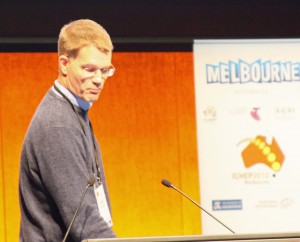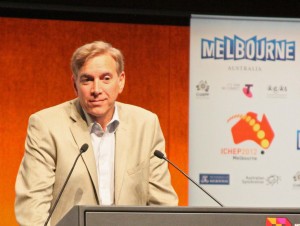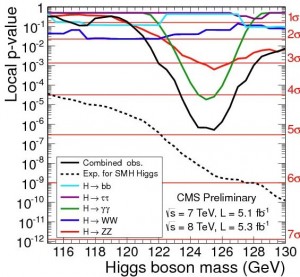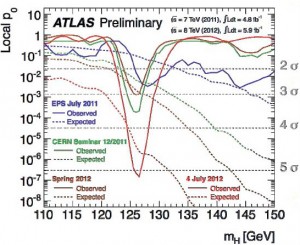

Richard Hawkings and Joseph Incandela presenting evidence at Melbourne from ATLAS and CMS for the discovery of a Higgs-like particle at LHC
One of the most rewarding features of physics research is the constant interplay between theory and experiment. The job of a physicist is to describe the physical world, and to advance our understanding of the laws of nature. Our science moves forward by the combination of experimentalists making observations that must be explained by theory, and theorists putting forward theoretical predictions that must be tested by experiment. The Standard Model of particle physics has been the centerpiece of our field for nearly 50 years. It has proven to be remarkably successful in describing the very large array of new measurements that have been carried out over the subsequent decades. Nevertheless, one feature of the Standard Model, the mechanism for generating mass, has yet to be confirmed and consequently has become the primary initial goal of the LHC. Peter Higgs first put forward the most accepted explanation for the generation of mass, based on electroweak symmetry breaking. Last month, we were presented with possible confirmation of this idea through evidence for what appears likely to be the first observation of the Higgs boson!
The searches for the Higgs, first at Fermilab, and then more sensitively at CERN’s LHC have systematically ruled out wide ranges of mass. Low masses up to a little more than a 100 GeV were ruled out early, and more recently LHC results have ruled out much of the region up to 500 GeV. The non-excluded regions are at relatively low Higgs mass, and therefore those energies have become the primary focus of the search. Results presented in December 2011 from both LHC experiments showing interesting hints of a signal near 125 GeV. However, they did not yet have the statistical significance to declare a discovery. The signature being sought was an excess of events that would result from the presence of a Higgs boson. Although both experiments saw indications, more data was required to reduce the probability of a statistical fluctuation to a very small probability. To declare a discovery, it has become customary in physics and astronomy to require observations having at least a “five-sigma signal,” which is where the probability of being fooled by a statistical fluctuation becomes less than one chance in two million.

The CMS narrow resonance signal evidence, broken up by decay mode and the combined five-sigma probability
In addition to the statistical significance of the result, confidence that a real signal has been observed is greatly increased because it is reported from two independent experiments, having complementary technical capabilities, different teams of physicists, and separate and independent data analyses. Finally, care has been taken in both experiments to eliminate human bias by performing what is called a ‘blind’ analysis, where the answer is only revealed after the analysis has been completed and finalised. The presentations at Melbourne make a very convincing case that a Higgs-like particle has been discovered. The whole process, from the operation of the accelerator, the technical understanding of the detectors, and the detailed data analysis leave little question that it is a new particle!

The development of evidence for a Higgs-like signal from the combined decay modes to five-sigma over time from ATLAS
The Higgs-like particle discovery is tremendously exciting for particle physicists, but it is only the first step in what will undoubtedly become a major thrust of the field. The first objective is to determine whether what has been observed is actually a Higgs boson. For example, does this new particle have the unique characteristics of a Higgs boson, for example having no spin and coupling strength proportional to mass? These and other characteristics will be tested as more data is accumulated at the LHC, or perhaps at a future lepton collider.
If it is established that what has been observed is a Higgs particle, the next set of questions will focus on whether it is a simple Standard-Model Higgs particle, or possibly a part of a more complex Higgs phenomenon. There are a number of variants of the Higgs phenomena that have been proposed theoretically. The future will be very interesting!


Recent Comments